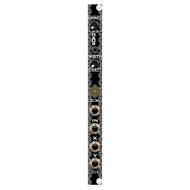Triple Cap Chaos – Zlob Modular
by Ellison Wolf
Zlob Modular’s new Triple Cap Chaos is based on the academic paper, Simple Autonomous Chaotic Circuits by J.C. Sprott and Jessica R. Piper. I have no idea how or where Zlob’s Keven Kalay came across this tome, or how time consuming it was to ingest and decipher its verbiage, but I find it pretty interesting that he built the Triple Cap based on their writing. Actually, this aspect, which is common enough in synths/modulars—of being inspired enough by something academic or historical for a means of creation—is something that continually excites me about our little corner of the world.
Due to the name, I was really expecting an uncontrollable, unpredictable, non-traditional distortion heavy module, but was instead surprised with a pretty well behaved—though intentionally static-y, non-linear, and dirty—sound sculpting device. While the sound/movement of the sound could be characterized as chaotic, the chaos can be controlled and harnessed, though a lot of times the TCC sounds like a broken module on the test bench. It makes me think of something I once read about Brian Eno, that when he had one of his synths repaired he had sticky notes all over it basically telling the tech that although parts of the synth were broken, and didn’t function “properly”, he liked it that way and not to mess with that while fixing the synth. He didn’t want the tech to break the broken parts that he liked. It’s this discernation of sound—this real listening and exploration to anything and everything that makes sound—that I really find impressive. I probably wouldn’t recommend taking this line of thinking to other aspects of life, like, when bringing in your car to a mechanic. Let ‘em fix what’s broken.
So what exactly is the Triple Cap Chaos? Zlob Modular touts it as a chaos based audio rate noise oscillator, harmonic generator, and overall mutilator of audio, but don’t let the term “oscillator” lead you astray though, as this isn’t your traditional VCO. Sporting the typical Zlob black and white panel art in a 2 HP size, TCC’s layout from top to bottom is as follows: The Emanate potentiometer controls the coarse behavior of the span of chaos, with the ability to go from something controllable to something, um, chaotic. The Width/CV ATT pot controls things in more of a fine manner and doubles as an attenuator when the CV in is patched, pretty standard fare. Below the CV in you find your audio IN, which is not a typical 1V/oct, and instead co-mingles with Emanate to alter the chaotic characteristics of the module. Finally, two outputs, X and Y, give you two sine/square based outputs.
Patching into the IN, Triple Cap works well—though on a limited frequency spectrum—as a ring mod-ish oscillator. Patching with the X output, basslines got crunchy and somewhat disappeared with minor bursts of distortion and limited bandwidth, and melodies the same. The Y output has a more present sound with more high end and I found it more useful for things I wanted to stick out as opposed to the X out that I liked using for texture and to add some extra substance to a multed signal. The two outputs are not quite yin and yang, but something of the sort and when used simultaneously panned hard left and right, opened up new worlds, especially when either or both signals were run through delay, reverb, phaser, etc.
You can use the Triple Cap as sort of a static heavy drone or rhythmic device as well, patching an envelope or LFO into the CV in and attenuating it as desired. Adding an attenuated sequence through a VCA into the IN brought about a drone with occasional mild melodic elements [due to the attenuation] that was really cool. I tried getting a decent percussion sound out of TCC, but wasn’t very successful in coming up with something useful for either application, but it wasn’t a surprise given the harmonic content being put out by Triple Cap.
The architecture of the Triple Cap might be based on chaos, but in use, it’s anything but. It’s a cool little module that will add some texture that just might be your thing. Offered as a DIY kit or a fully assembled module.
2 HP +12v: 15mA -12v: 10mA
Price: from $20 - $75


